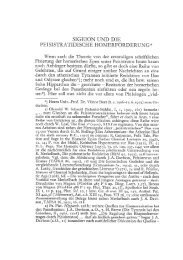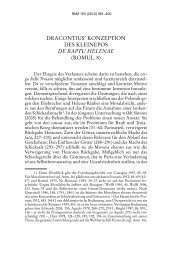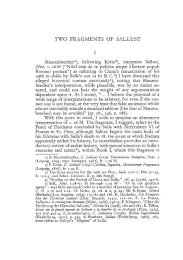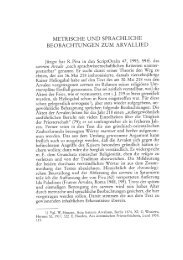THE GEOGRAPHY OF THE PROMETHEUS VINCTUSI
THE GEOGRAPHY OF THE PROMETHEUS VINCTUSI
THE GEOGRAPHY OF THE PROMETHEUS VINCTUSI
You also want an ePaper? Increase the reach of your titles
YUMPU automatically turns print PDFs into web optimized ePapers that Google loves.
The Geography of the Prometheus Vinctus 123<br />
located in the south of the European continene. Let us suppose<br />
now that the picture of Europe given in the P.V. was set out as a<br />
real description of the continent's geography rather than as a wild<br />
fantasy. With this in view, let us try to answer the following<br />
question: what mountain range of great height lies in the south of<br />
Europe, and what river flowing into the northern ocean takes its<br />
origins in this range? One can hardly avoid the conclusion that the<br />
mountain range would be the Alps and the river the Rhine.<br />
As far as I can see, this conclusion goes weIl with Bolton's<br />
identification of the "Caucasus" of the P.V. with the fabulous<br />
Rhipaean mountains, the seat of the northern wind 8 . Note that the<br />
Rhipaean mountains are the traditional location of the sources of<br />
the Ister 9 , and the sources of the Ister (the Danube) do in fact lie in<br />
the Alps. The blessed folk of the Hyperboreans to whom Apollo<br />
paid regular visits were usually represented as living nearbylO. This<br />
seems to have been the reason why, as actual knowledge of Europe<br />
to the north of the Mediterranean increased, the Rhipaean mountains<br />
together with the Hyperboreans dwelling in them began to<br />
move in a northerly direction, towards still unknown parts of the<br />
world, until eventually they were located near the north pole itself.<br />
However, the sources of the Ister could not be moved as easily as<br />
the Hyperboreans, and the traditional position of these sources in<br />
the Rhipaean mountains is the best proof that the location of the<br />
range in the south of Europe is the original one. It is significant in<br />
this connection that not only are the Rhipaean mountains sometimes<br />
explicitly identified with the Alps!!, but they can also be<br />
regarded as part of the same range as the traditional Caucasus (see<br />
n.6 above).<br />
As for the river Hybristes, its identification with the Rhine<br />
7) And not in its extreme norch as in Bolton's reconstruction, see Bolton<br />
52-53. In general outline, my reconstruction of lo's European route agrees with<br />
that of Griffith, see his map in Griffith vi, and his criticism of Bolton ibid. 217-218<br />
(ad 719-21). Cf. also Thomson 59--60: "The poet Aeschylus takes the wildest<br />
libercies with geography, even putting the Chalybes and the Caucasus vaguely<br />
north-west of the Kerch strait."<br />
8) Bolton 52-53.<br />
9) See Aesch. Fr. 197 Radt apo schol. Ap. Rhod. 4.284; Ap. Rhod. 4.282-87;<br />
cf. Pind. 01. 3.13ff., 8.46ff. and Bolton 52-53.<br />
10) See esp. Pind. 01. 3.13ff.: YAUU'X0XQou 'XOOIlOV EAULUC;, l:OV nOl:E /<br />
'1ol:Qou uno o'XLuQäv / nuyäv EVEL'XEV 'AWPLl:QUWVLOÖUC;, / Ilvällu n1>V OUAU!lJtLm<br />
'XOf"f"Wl:OV MSAWV, / öällOV 'YnEQßoQfWV nELomc; ,Anof,,/AwvoC; SEQonovw AOy<br />
WL; cf. Aesch. Fr. 197 Radt; Ap. Rhod. 4.282-87; schol. Ap. Rhod. 4.284.<br />
11) Posidonius, FGrHist 87 F 103 (= schol. Ap. Rhod. 2.675); Steph. Byz.<br />
S.V. 'YnEQßoQELOL, see furcher Bolton 157 and n.19.

















